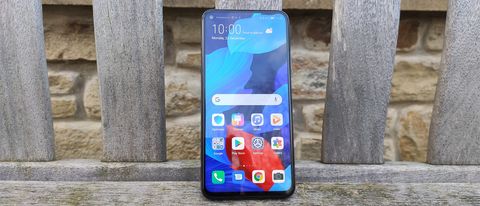Tom's Guide Verdict
The Huawei Nova 5T offers a smart design, decent cameras and effective performance along with access to Google apps.
Pros
- +
Fast lock/fingerprint sensor button
- +
Main and wide photography works well
- +
Compact design fits into your hand easily
- +
Attractive and premium-feeling exterior
Cons
- -
Night mode photography is subpar
- -
Macro lens is hard to use
- -
LCD display can’t match up to most OLED screens
- -
Lots of Huawei bloatware apps
- -
No US availability
Why you can trust Tom's Guide
The last 12 months haven’t been good ones for Huawei. Thanks to the US government’s blacklist, the Chinese phone giant can no longer use Google Mobile Services, disabling some of the most defining software elements from Huawei’s handsets.
But Huawei’s trying to start the new year on a high note, producing one last phone that arrives with Google services included.
The Huawei Nova 5T costs £400 (roughly $530), and because the phone launched in China before the U.S. blacklist went into force, it’s still permitted to use Google Mobile Services. As a result, the Nova 5T behaves just like any other Android phone, meaning this isn’t a Huawei device you should skip over.
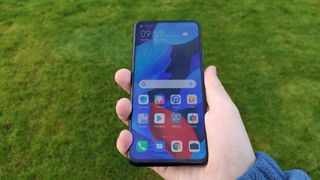
When you do look at the Nova 5T, though, you will notice that its middle-of-the-road approach sometimes lets the phone down — particularly when it comes to the 5T’s display, photo output and many of its preloaded apps. Additionally, the Nova 5T isn’t on sale in the US, meaning rivals like the $399 Google Pixel 3a and $479 Pixel 3a XL look all the more appealing.
The Nova 5T faces tough competition, but if you want the Huawei ecosystem or a generally good hardware experience on a phone at a reasonable price, this is a pretty good option.
Huawei Nova 5T review cheat sheet
- You can’t buy the Nova 5T in the US, but UK users can get a quality-feeling and -looking product for £400.
- The 6.2-inch LCD display is the right mix of size and compactness, but isn’t super colorful or bright.
- The main 48MP camera and the wide 16MP camera take good and bright photos. The macro lens and the phone’s night mode don’t match up however.
- 6GB RAM plus a Kirin 980 processor gives you just enough performance power for any need you may have.
- You can have any Google app you like, thanks to the US ban bypass, but you will find lots of Huawei’s own apps the first time you open the phone up.
- Unless you’re a smartphone power user, 3,750 mAH of battery capacity plus 22.5W fast charging will make sure you don’t lack for battery life.
Huawei Nova 5T price and availability
In the UK, the Nova 5T is available in a single version with 6GB RAM and 128GB storage, which will cost you £399. For color, you get a choice of black, Midsummer Purple or Crush Blue.
The Nova 5T is already on sale in the UK, where you can buy it from stores such as EE (where you get a free pair of Huawei Freelace wireless headphones as a sweetener), Carphone Warehouse, O2, or Vodafone.
If you’re in the US, you’ll have to import the Nova 5T if you want this Huawei model. Make sure that you check your mobile carrier is compatible with the handset you’re buying if you do this, but to be honest you’re probably better off looking at another device, especially given the number of high-quality, low-cost unlocked Android phones there are these days.
| Row 0 - Cell 0 | Huawei Nova 5T |
| Price | £399 |
| Screen (Resolution) | 6.26-inch LCD (2340 x 1080) |
| CPU | Kirin 980 |
| RAM | 6GB |
| Storage | 128GB |
| Rear Camera(s) | 48-MP Main (f/1.8), 16-MP wide (f/2.2), 2-MP depth assistant (f/2.4), 2-MP macro (f/2.4) |
| Front Camera | 32-MP (f/2.0) |
| Battery | 3,750 mAh |
| Colors | Black, Midsummer Purple, Crush Blue |
| Size | 6.1 x 2.9 x 0.3 inches (154.3 x 73.9 x 7.87mm) |
| Weight | 6.1 ounces (174g) |
| SD Card? | No |
Huawei Nova 5T design
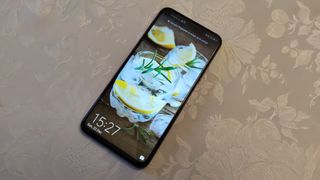
If you’ve seen the front of the Honor 20 Pro, you’ve basically seen the front of the Nova 5T. These phones are identical, from the thick bottom bezel to the punch-hole selfie camera in the top left corner of the display. This makes more sense on the Honor 20 Pro, since it replicates the Honor View 20’s punch-hole display, whereas the Nova looks like no other phone baring the Huawei badge. It’s unlikely that Huawei’s going to change its mind about front designs for the P40 or Mate 40 later this year, which will leave the Nova 5T as the odd one out in its lineup.

It’s another story on the back, where you’ll notice a few differences between the Nova and its Honor counterpart. The Nova 5T has its flash built into the main three-camera module in the top left corner, whereas the 20 Pro places it underneath the macro lens to the side of the main camera bump. There’s also a small illustration representing the four cameras on the Nova, as well as the Huawei logo placed sideways along the left edge of the phone, as is Huawei’s tradition.
Holding the phone, you’ll notice that despite its 6.2-inch screen, the Nova 5T’s tall and skinny frame makes it comfortable to use with one hand, with your thumb or middle finger resting in the power button/fingerprint scanner cutout. I know several people who are unwilling to trade in older phones because they don’t like the size of modern devices, but the Nova 5T may convince them that larger displays don’t have to mean less ergonomic phones.
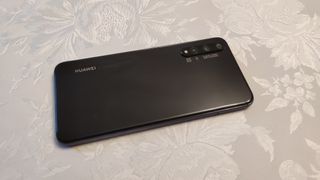
The 5T’s color options cover the bases well. The black color, which you can see in the images in this review, has a simple shine, making it the most subtle of the color choices. The Crush Blue looks similar but is a little more colorful for people who find the black version too boring, while the Midsummer Purple goes all out with a brand new Nova logo at the bottom of the phone, with the letters of this logo in a slightly different shade of purple inlayed in a pattern up and down the back.
Huawei says that it’s aiming at a younger potential customer base than usual with the Nova, and these two brighter colorways are clear evidence of that choice. It’s not a huge variety of colors, but you’ll be at least satisfied with the options whether you want a phone that does or doesn’t draw attention to itself.
Huawei Nova 5T display
Just like the Honor 20 series, the Nova features an LCD 6.26-inch FHD+ punch-hole display. That means a near-full screen viewing experience, but you lose out on the better colors of an OLED display.

On the plus side, I was happy using the Huawei Nova 5T outdoors in the harsh English winter sun, and never had to think about touching the brightness slider.
Comparing it with a pair of OLED phones by watching the cartoony but informative YouTube educational challenge Kurzgesagt, the Nova 5T beats the display of the Google Pixel 3a, which is notably dim for this type of display, though Huawei’s phone doesn’t match the OLED of the Xiaomi Mi 9T Pro for brightness or color.
Huawei Nova 5T cameras
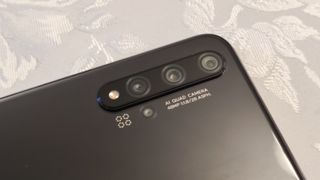
On the back of the Nova, you’ll find four cameras — the main 48MP sensor in the middle of the main bump, with the 16MP wide sensor above, the 2MP depth assist sensor below and the 2MP macro sensor on its own to the right.
The 48MP sensor makes use of pixel-binning, or "light fusion" in Huawei’s own terminology, to make 12MP images that deal better with low-light conditions or just a dreary day in the UK, which I faced when I took the Nova out for some camera testing.
This bridge is far brighter in the Nova’s image than it is in the Google Pixel 3a’s, but the brightness costs color saturation, which makes the picture taken by the Pixel 3a preferable in a key area for some photographers.
Swapping the two phones to their respective night modes and heading out after dark shows one of the Nova’s photographic weaknesses. This image of the barbican (front gate) of the local castle decorated for Christmas is much blurrier on the Nova, plus the bricks have turned a funny shade of yellow and the sky is not as dark as it should be. It’s OK, but Google has the better low-light mode in Night Sight, even on its cheapest handset.
I used the wide lenses on the Mi 9T Pro and the Nova 5T to take a picture of this indoor shopping arcade and Huawei’s obsession with brightness pays off here. Although the area is well lit with skylights and electric lighting, you can make out details a lot deeper into the Huawei image. It also helps that the Nova has a slightly higher resolution than the Xiaomi (16MP to 13MP), but this is a situation where Huawei’s particular flavor of software processing shines.
When you go into the Nova’s camera app, you’ll see at the bottom the more common buttons that swap between standard, wide and telephoto camera modes. The Nova 5T doesn’t have a telephoto sensor, but rather uses its 48MP main sensor to zoom in digitally. It’s a good half-measure, since 48MP is one of the largest sensor sizes you can buy on a phone at the moment, and zooming in on such a large image won’t instantly ruin the photo quality. But it’s not the same as a proper optical zoom lens.
In this 2x zoom comparison shot of a clock tower with the Mi 9T Pro (which does have a 2x optical zoom camera) you can see the 5T loses definition on the edges of objects like the hands of the clock, casting the bricks in an inaccurate yellow hue. That’s despite the fact that the Xiaomi’s zoom camera is 8MP, and as a result produced a much smaller image than the Nova. Huawei often has the best hardware in its class, but in this example, Xiaomi has it beaten and has a better image to show off as a result.

The Nova 5T's macro sensor is something you’ll appreciate if you like to take close-ups. The phone did a pretty good job capturing the foam on the top of my coffee, but it took me several attempts to get this shot. That's because I could easily block the light from the image just by holding the phone in a slightly different position over the cup. Without enough light hitting the tiny 2MP sensor, the white and brown foam turned a hideous gray color.
Still, you can get a lot of use out of the macro lens if you have much more consistent sunlight or some artificial light with which to work.

Finally, on the front of the Nova 5T, we have the 32MP selfie camera. It’s a very high resolution because of the target audience (young people just love their selfies after all), and it comes with AI beautification features (which in the interests of honest tech journalism I switched off for this comparison), as well as a bokeh-style portrait mode.
We see more major color differences when comparing selfies with the Nova to the Pixel 3a. The fact that the 32MP front sensor of the Nova is on paper hugely superior to the 8MP sensor of the Pixel is not as important to the way the two images make the same subject look very different. Google has made the cold winter’s day and my pale skin look like it’s a sunny day and I’ve got a very uncharacteristic tan. The Nova’s image is far more honest, which combined with the higher resolution means that I’ve got to give it the nod here despite the fact that I’d be far more tempted to upload the Pixel’s image on my Instagram.
If you’re using one of the two large rear cameras of the Nova 5T and don’t mind some extra brightness, you’ll get a class-leading image. The 5T’s digital zoom makes a valiant effort, but can’t match up to optical zoom on other phones, while its night mode isn’t quite as good as what the Pixel 3a offers. The 5T’s macro lens is far too finicky for quick and easy photography while its selfie camera will divide opinions.
Huawei Nova 5T performance
The Nova 5T is equipped with the Kirin 980 CPU, Huawei’s top CPU from 2018 (The Kirin 990, found in the Mate 30 series, has since taken its place.) Along with that CPU, you get 6GB RAM and a Mali-G76 GPU, which gives the Nova well above average performance, but nothing earth-shattering.
Comparing the Nova 5T to its competition on synthetic benchmark app Geekbench 5, the results show the Nova thoroughly beating the Pixel 3a’s lower-tier Snapdragon 670 CPU and 4GB RAM combo with a multicore score of 2,392 to 1,327. The Xiaomi Mi 9T Pro uses a Snapdragon 855 CPU, a direct rival to the Kirin 980, and also 6GB RAM, which makes its similar but slightly better benchmark score of 2,457 unsurprising.
Moving over to graphics tests, I used 3DMark’s Slingshot Extreme OpenGL benchmark and managed a score of 4,040. This blazes past the Pixel 3a’s 1,602, but falls well short of the Mi 9T Pro, which managed 5,098 with its Adreno 640 GPU.
For some real-life testing, I booted up the fun and high fidelity Asphalt 9: Legends. As I played, the Nova 5T didn’t struggle to keep up with the fast moving high resolution vehicles on screen, and stayed fairly cool to the touch too. It wasn’t the best quality I’ve ever seen the game played at, but it’s not bad looking by any measure.
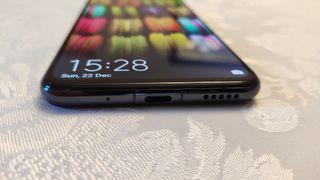
Huawei Nova 5T software and OS
Like other Huawei phones, the Nova 5T runs on EMUI 9, the Huawei flavored version of Android 9, which remains a good operating system. The Android 10-powered EMUI 10 will arrive on the Nova 5T this month.
With EMUI, you get Huawei ID and the accompanying ecosystem of apps like the Huawei App Gallery (not much good for users outside China) and its own crop of basic apps like music player, web browser, email, file browser, notes, calendar and health tracking. These all are fine, but some only work at their best if you sign up for a Huawei ID and use more Huawei products like the Watch GT 2 smartwatch or the FreeBuds 3. It’s the typical story with so-called “bloatware” — if you’re a brand fanatic, you’ll like it, otherwise you’ll just see them as taking up precious home screen space and quickly stuff them all in a folder and never use them again (and no, you can’t delete them).
The Nova 5T is a little unique within Huawei’s recent lineup as it can still use Google Mobile Services, thanks to its launch in China before the full US government ban hit. That means you can use any Google Play Store app you like without any hindrance, which wouldn’t be a feature worth mentioning on any other Android phone, but Huawei finds itself in a unique position these days.
Nova 5T fingerprint scanner
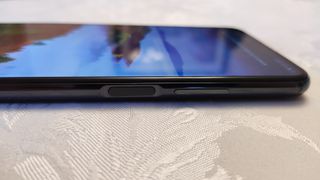
The Nova 5T doesn’t use a sub-display optical fingerprint scanner that’s becoming more popular on Android phones. Instead, you get a capacitive sensor like the Samsung Galaxy S10e. This sounds a little old-fashioned, but in an inspired move, the Nova 5T has placed this sensor on the phone’s lock button and located it where you’d expect on a modern phone — midway up the right edge of the 5T. So rather than having to press the unlock button and then adjust your grip to place your finger on the sensor area at the bottom of the phone, you can just pick up the phone as you normally would and have it unlocked by the time you’re in a position to use it. This is much better than Samsung's decision to place its lock button near the top of the S10e's right edge, which means you still have to shift your hand to use it.
Huawei estimates it only takes 0.3 seconds for the phone to unlock, which is fast enough as it is. But during my testing I found that Huawei’s approach is still far more reliable than any optical fingerprint scanner I’ve tried, sometimes unlocking with even a very slight touch of the sensor. I’d love to see this feature on other phones at this price, but assuming that Huawei doesn’t give away its design secrets, this remains one of the best quality of life features on the Nova 5T.
Huawei Nova 5T battery Life and charging

The Nova 5T uses a 3,750 mAh battery, which is a little smaller than the 4,000 mAh average of phones released this year. But considering the LCD display and average performance figures, this smaller size isn’t a big deal for battery life, as the phone will comfortably pass a normal work day, with internet browsing, social media checking and video watching, away from a power source.
In the box you have a 22.5W fast charging plug, which promises 50% of a full charge within 30 minutes. After trying this for myself, I actually managed 44% in half an hour. Even though it charges a little slower than expected, this is still enough power for an effective top-up during the day.
Bottom line
For a phone of its price, the Huawei Nova 5T met our expectations and sometimes exceeded them. It’s attractive, feels modern to use despite some older components, and is smartly engineered, particularly the outer shell with its narrow chassis and fingerprint scanner/unlock button combination. And because it still has Google Apps and the Play Store available, it’s a phone suitable for anyone, not just Huawei diehards who are willing to get the company’s products at any cost.
There are meaningful distinctions between the Nova 5T and its rivals. You get more features, power and a straight-up larger phone for your money with the Nova 5T than you would buying a Pixel 3a or Pixel 3a XL, but having a purer Android experience and more flattering photo processing with Google’s phone are important advantages.
The Mi 9T Pro is a closer comparison point. The extra size and weight of the Xiaomi in exchange for a larger display and pop-up camera is worth it, I’d argue, and you also enjoy features such as an OLED display, optical zoom camera and larger battery.
Overall though, I can’t find many problems with the Nova 5T — just different priorities compared to its rivals. Buy this phone if you’re looking for some premium quality and a well rounded set of features at a mid-range price, but look to Google or Xiaomi if you have more specific needs.

Richard is based in London, covering news, reviews and how-tos for phones, tablets, gaming, and whatever else people need advice on. Following on from his MA in Magazine Journalism at the University of Sheffield, he's also written for WIRED U.K., The Register and Creative Bloq. When not at work, he's likely thinking about how to brew the perfect cup of specialty coffee.
